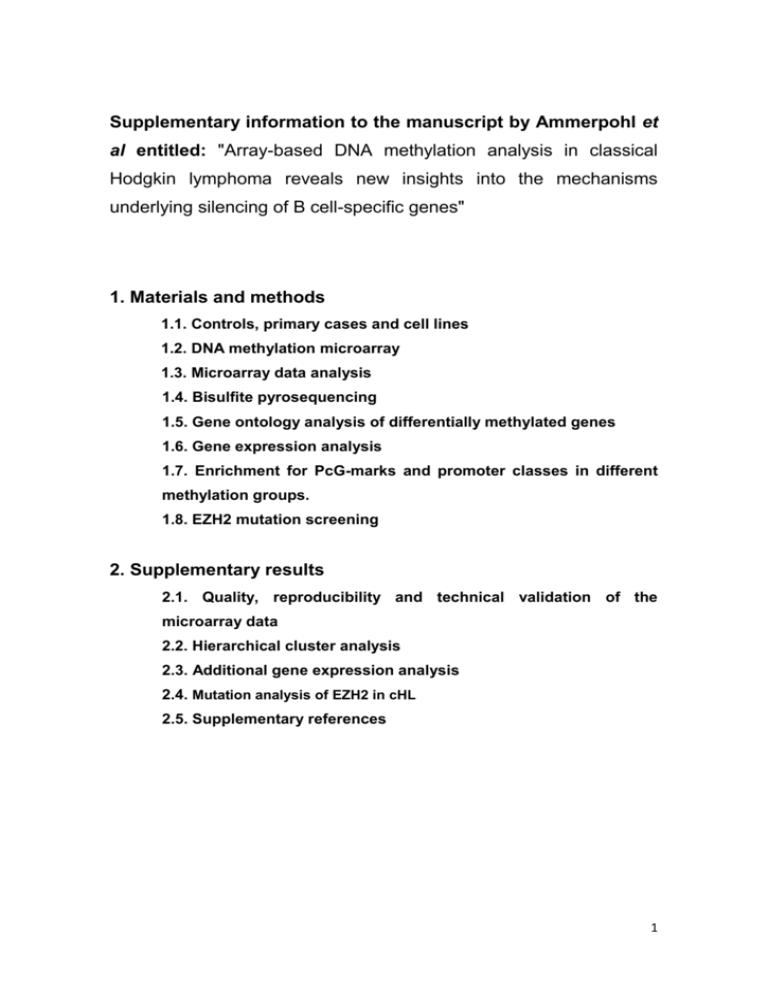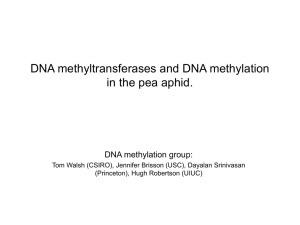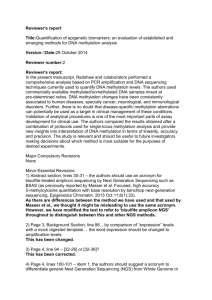Supplementary Material (doc 120K)
advertisement

Supplementary information to the manuscript by Ammerpohl et al entitled: "Array-based DNA methylation analysis in classical Hodgkin lymphoma reveals new insights into the mechanisms underlying silencing of B cell-specific genes" 1. Materials and methods 1.1. Controls, primary cases and cell lines 1.2. DNA methylation microarray 1.3. Microarray data analysis 1.4. Bisulfite pyrosequencing 1.5. Gene ontology analysis of differentially methylated genes 1.6. Gene expression analysis 1.7. Enrichment for PcG-marks and promoter classes in different methylation groups. 1.8. EZH2 mutation screening 2. Supplementary results 2.1. Quality, reproducibility and technical validation of the microarray data 2.2. Hierarchical cluster analysis 2.3. Additional gene expression analysis 2.4. Mutation analysis of EZH2 in cHL 2.5. Supplementary references 1 1. Materials and methods 1.1. Controls, primary cases and cell lines We analyzed a total of 25 B cell lymphoma samples by DNA methylation microarrays. These included the five cHL cell lines L-1236, L-428, KM-H2, HDLM-2 (German Collection of Microorganisms and Cell Cultures) and U-HO1 (1) (kindly provided by Andreas Bräuninger, University Hospital Münster, Germany), and 20 gcdBCL. The latter included the BL cell line Raji (BioChain Institute, CA, USA) and the FL cell line RL (kindly provided by Charles W. Caldwell, University of Missouri, USA) as well as 18 primary lymphomas defined by transcriptional and genomic profiling (2) (six molecular BL (mBL), seven germinal center B cell (GCB) DLBCL, and five activated B cell (ABC) DLBCL). As normal B cell (NBC) controls, we used the NA06999 lymphoblastoid cell line (Coriell Institute for Medical Research, Camden, NJ, USA), tonsillar centroblasts (CD77+) and tonsillar germinal center B cells (CD19+, CD20high, CD38+). We also used in vitro methylated DNA (M.SssI methyltransferase, New England Biolabs, MA, USA) and whole genome amplified DNA (REPLI-g MiniKit, Qiagen, Hilden, Germany) as positive and negative technical controls for the microarray analyses (3), respectively. Part of the cases studied herein have been published before. Genomic and transcriptional profiling of the 18 gcdBCL primary cases included in the study has been published in Hummel et al. (2). A partial analysis of DNA methylation data from these cases as well as from the NA06999 lymphoblastoid cell line and tonsilar germinal center B-cells (CD19+, CD20high, CD38+) has been published in Martin-Subero et al. (4). The PLAGL1 primers used for bisulfite pyrosequencing have been published in Martin-Subero et al. (5) The primary lymphomas studied herein belong to the network project “Molecular Mechanisms in Malignant Lymphomas (MMML)”, for which central and local ethics approval was obtained. 2 1.2. DNA methylation microarray We used the Infinium Assay from Illumina (San Diego, CA) for genome-wide DNA methylation analyses. The panel is developed to quantify the DNA methylation status of 27,578 CpG sites located within the proximal promoter regions (1 kb upstream and 500 bp downstream of transcription start sites) of 14,475 well-annotated genes from the consensus coding sequence project as well as known cancer genes and microRNAs (3). Briefly, genomic DNA is converted by sodium bisulfite treatment and whole-genome amplified using the manufacturer’s instructions. Each CpG locus is represented by two bead types: one for the unmethylated (U) site and another for the methylated (M) site. After hybridization and single-base extension using labelled nucleotides, the intensity of the U and M beads is measured with a microarray reader. The methylation status of a CpG is determined by the beta-value calculation, which is the ratio of the fluorescent signals between the M bead to the total locus fluorescence intensity. 1.3. Microarray data analysis Before analyzing the methylation data (so called beta values, which range from 0 for unmethylated to 1 for completely methylated), we excluded possible sources of biological and technical biases that could alter the results. As the X chromosome shows differential methylation in men and women and chromosome Y is only present in males, we excluded all 1,092 CpGs on chromosomes X and Y to avoid a gender-specific bias. Additionally, we selected exclusively high quality CpGs by filtering out 2,174 CpGs with bad detection p values (p>0.01) in at least one sample. Using these strict criteria, a total of 24,312 high-quality CpGs (13,088 genes) entered further statistical analyses (raw data shown as supplementary information). As 7 of the 28 studied samples were analyzed in duplicate, we measured the reproducibility of the Infinium microarray by performing scatter plots and calculating the coefficients of determination. Unsupervised hierarchical clustering was performed using the Cluster Analysis tool of the BeadStudio software (version 3.2). A differential methylation analysis was performed with the R statistical software (http://www.R-project.org). Using previously reported criteria for DNA methylation analyses with Illumina arrays 3 (4), a given CpG was classified as differentially methylated between cases and controls if the difference between mean beta values was at least 0.25 in the two compared groups, and the false discovery rate (FDR) of a Wilcoxon test for independent samples was below 0.05. 1.4. Bisulfite pyrosequencing Genomic DNA was bisulfite converted using the EpiTect Bisulfite Conversion Kit (Qiagen, Hilden, Germany), according to manufacturer’s instructions. Bisulfite pyrosequencing was performed according to standard protocols and evaluated with the analysis software Pyro Q-CpG 1.0.9 (Biotage, Uppsala, Sweden), which was also used to quantify the percentage of methylated cytosines at the analyzed CpG sites. PCR and primer sequences are shown in Table S1. 1.5. Gene ontology analysis of differentially methylated genes The Gene Ontology enRIchment anaLysis and visuaLizAtion tool (GOrilla, http://cbl-gorilla.cs.technion.ac.il) was used to determine the enrichment of individual ontology terms and create gene ontology maps in the groups of differentially methylated genes as compared with the 13,088 genes studied with the Infinium array (6). 1.6. Gene expression analysis Normalized Affymetrix U95A gene expression data from normal B cells, cHL cell lines as well as gcdBCL cell lines and primary cases were obtained from the supplementary material of a publication by Küppers and coworkers (7). We analyzed the percentage of absent and present detection calls for genes differentially methylated in cHL and/or gcdBCL. 1.7. Enrichment for PcG-marks and promoter classes in different methylation groups. Proportions of PRC2 targets in genes commonly or differentially methylated in cHL and gcdBCL were compared with the proportion of PRC2 targets in all genes included in the Infinium Illumina Array using Fisher’s exact test. ChIPSeq genome-wide maps of EZH2 and 3mK27H3 genes in ESCs and normal germinal center B cells (centroblasts) was obtained from Ku et al. (8) and 4 Velichutina et al. (9), respectively. To analyze whether promoter regions of the methylation groups showed different CpG compositions, we classified them into promoters with high (HCP), intermediate (ICP) and low (LCP) CpG content according to a previously published study (10). 1.8. EZH2 mutation screening Genomic DNA from five cHL cell lines (L-1236, L-428, KM-H2, HDLM-2 and UHO1) was used for screening of mutations in the coding region of EZH2. Sequencing was performed using previously published primers (11, 12) according to conventional methods using an ABI PRISM® 310 Genetic Analyzer capillary sequencer (Applied Biosystems, Darmstadt, Germany). 2. Supplementary results 2.1. Quality, reproducibility and technical validation of the microarray data After filtering sex chromosome-specific and low quality CpGs as outlined in the methods section, a total of 24,312 autosomal CpGs from 13,088 genes entered the statistical analyses. The mean coefficient of determination between replicates (seven samples) was 0.987 (ranging from 0.984 to 0.991) (Figure S1) demonstrating the high reproducibility of the assay. To technically validate the results by an independent method, we compared the DNA methylation level of 14 different CpGs (11 genes) present in the Infinium array to the levels measured by bisulfite pyrosequencing in the five cHL cell lines and the Raji cell line (Primers are shown in Table S1). These comparisons indicated that DNA methylation levels detected with both methods are highly correlated (Spearman correlation coefficient = 0.86, p<0.001, Figure S2). 2.2. Hierarchical cluster analysis A hierarchical cluster analysis of the methylation values of the 24,312 CpGs entering the evaluation is shown in Figure S3. This analysis shows that the positive and negative technical controls are fully methylated and fully unmethylated, respectively, and cluster separately. Normal B cells (NBCs) show DNA methylation profiles clearly different from most lymphoma samples. 5 Classical HL and gcdBCL cell lines along with one primary case show the highest number of hypermethylated genes of all samples studied. This finding suggests either that lymphoma cell lines are developed from primary cases with highly altered DNA methylomes and/or that some epigenetic changes are acquired in vitro. Within lymphoma subtypes, cHL and gcbBCL (FL and BL) cell lines cluster separately, suggesting the presence of specific DNA methylation patterns associated to these entities. 2.3. Additional gene expression analysis As shown in figure 2 of the manuscript, genes Hmet-cHL showed a higher percentage of absent calls (i.e. not expressed) in cHL (62%) than in NBCs (32%) and gcdBCL (40%). As the link between hypermethylation and silencing in cHL might be affected by the fact that the group of gcdBCLs is made out of different lymphoma entities, we studied BL and DLBCL separately. In particular, we took those genes silenced only in cHL as compared to gcdBCLs and we calculated the percentage of absent calls in cHL, BL and DLBCL. As shown in figure S4, these genes are mostly silenced both in BL and DLBCL. This result further supports the finding that genes silenced in cHL target the B cell program, which is expressed in BL and DLBCL. 2.4. Mutation analysis of EZH2 in cHL As the Tyr641 EZH2 mutation, which enhances EZH2 activity (13), has been recurrently detected in gcdBCLs (14), we screened the same five cHL cell lines used for DNA methylation profiling for EZH2 mutations. Indeed, we could identify a heterozygous mutation A>C in the cell line L428 leading to a tyrosine to serine alteration at codon 641 (Tyr641) (Figure S8). 6 2.5. Supplementary references 1. 2. 3. 4. 5. 6. 7. 8. 9. 10. 11. 12. 13. 14. Mader A, Bruderlein S, Wegener S, Melzner I, Popov S, Muller-Hermelink HK, et al. U-HO1, a new cell line derived from a primary refractory classical Hodgkin lymphoma. Cytogenetic and genome research 2007; 119: 204-210. Hummel M, Bentink S, Berger H, Klapper W, Wessendorf S, Barth TF, et al. A biologic definition of Burkitt's lymphoma from transcriptional and genomic profiling. The New England journal of medicine 2006; 354: 2419-2430. Bibikova M, Le J, Barnes B, Saedinia-Melnyk B, Zhou L, Shen R, et al. Genome-wide DNA methylation profiling using Infinium® assay. Epigenomics 2009; 1: 177-200. Martin-Subero JI, Kreuz M, Bibikova M, Bentink S, Ammerpohl O, WickhamGarcia E, et al. New insights into the biology and origin of mature aggressive Bcell lymphomas by combined epigenomic, genomic, and transcriptional profiling. Blood 2009; 113: 2488-2497. Martin-Subero JI, Bibikova M, Mackay D, Wickham-Garcia E, Sellami N, Richter J, et al. Microarray-based DNA methylation analysis of imprinted loci in a patient with transient neonatal diabetes mellitus. American journal of medical genetics 2008 Dec 15; 146A(24): 3227-3229. Eden E, Navon R, Steinfeld I, Lipson D, Yakhini Z. GOrilla: a tool for discovery and visualization of enriched GO terms in ranked gene lists. BMC bioinformatics 2009; 10: 48. Küppers R, Klein U, Schwering I, Distler V, Brauninger A, Cattoretti G, et al. Identification of Hodgkin and Reed-Sternberg cell-specific genes by gene expression profiling. The Journal of clinical investigation 2003; 111: 529-537. Ku M, Koche RP, Rheinbay E, Mendenhall EM, Endoh M, Mikkelsen TS, et al. Genomewide analysis of PRC1 and PRC2 occupancy identifies two classes of bivalent domains. PLoS genetics 2008; 4: e1000242. Velichutina I, Shaknovich R, Geng H, Johnson NA, Gascoyne RD, Melnick AM, et al. EZH2-mediated epigenetic silencing in germinal center B cells contributes to proliferation and lymphomagenesis. Blood 2010; 116: 5247-5255. Weber M, Hellmann I, Stadler MB, Ramos L, Paabo S, Rebhan M, et al. Distribution, silencing potential and evolutionary impact of promoter DNA methylation in the human genome. Nature genetics 2007; 39: 457-466. Pellissery S, Richter J, Haake A, Montesinos-Rongen M, Deckert M, Siebert R. Somatic mutations altering Tyr641 of EZH2 are rare in primary central nervous system lymphoma. Leukemia & lymphoma 2010; 51: 2135-2136. Ernst T, Chase AJ, Score J, Hidalgo-Curtis CE, Bryant C, Jones AV, et al. Inactivating mutations of the histone methyltransferase gene EZH2 in myeloid disorders. Nature genetics 2010; 42: 722-726. Yap DB, Chu J, Berg T, Schapira M, Cheng SW, Moradian A, et al. Somatic mutations at EZH2 Y641 act dominantly through a mechanism of selectively altered PRC2 catalytic activity, to increase H3K27 trimethylation. Blood 2011; 117: 2451-2459. Morin RD, Johnson NA, Severson TM, Mungall AJ, An J, Goya R, et al. Somatic mutations altering EZH2 (Tyr641) in follicular and diffuse large B-cell lymphomas of germinal-center origin. Nature genetics 2010; 42: 181-185. 7





